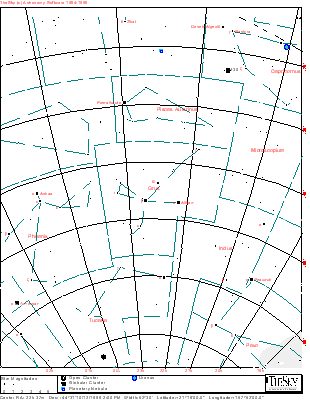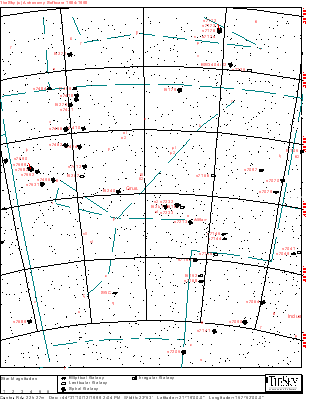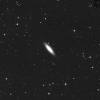
| Home | Deepsky Atlas | TheAstronews | Links | Solar System | ||||||

Hawaiian Astronomical SocietyConstellations: Grus -- Observing the time of its Coming |
||||||||||
Caesius co-authored the book with Bayer and Julius Schiller (1759 - 1805), using Bayer's Uranometria as its model. Caesius died before the book could be completed, and Schiller saw the book through to publication, making a few changes as he went along. It seems he is responsible for some of the more far fetched Christian constellations. Grus might be one of them. Why call this region of sky the "stork," when the same biblical passage mentions the crane?
You can find good illustrations Caesius' and Schiller's work here.

Click the map for a 929x1200 version of the above. Click here for a map better suited for use in the field.

This a more detailed view of the constellation. The map displays stars to magnitude 10, and deepsky objects to magnitude 12. Click here for a map better suited for use in the field.
 28k JPEG NGC7410 (Bennett 129a) is a spiral galaxy located in north-western Grus, 4.5° WNW of Theta Gruis. Dreyer call it quite bright (mag. 11.5), large (5.3'x1.6'), very moderately extended (p.a. 43°, with a much brighter middle. A 4" will show its elongation. 28k JPEG NGC7410 (Bennett 129a) is a spiral galaxy located in north-western Grus, 4.5° WNW of Theta Gruis. Dreyer call it quite bright (mag. 11.5), large (5.3'x1.6'), very moderately extended (p.a. 43°, with a much brighter middle. A 4" will show its elongation.
|
 42k JPEG Four rather dim galaxies inhabit this area of northern Grus near the border of Pisces Austrinus and Sculptor. Here are their descriptions from north to south: 42k JPEG Four rather dim galaxies inhabit this area of northern Grus near the border of Pisces Austrinus and Sculptor. Here are their descriptions from north to south:
IC1459 (Bennett 129b) is described as faint (mag. 10) and fairly small (5.3'x3.8'). It looks much like a comet, complete with 12th magnitude nucleus. IC5264 sits 6.5' south of IC 1459. Shining at mag. 13.4 (photographic), and covering 2.5'x.5' of sky, this edge on galaxy (p.a. 82°) looks faint in a 13". NGC7418 is a face on spiral galaxy described as quite bright (mag. 11.4), very large (2'x1.8'), very little extended, very gradually brightening a little toward the middle. It lies 28' south of IC5264. NGC7421 sits 19' south of NGC7418. It shines at mag. 12.7 and covers (2.0'x1.8'). Dreyer calls it quite bright, large, very little extended, gradually westward much brighter middle, and resolvable. Dreyer may have been a tad optimistic.
And if you are a glutton for punishment, NGC7418a, shining at mag. 14, lies just north of NGC7418. Good luck.
|
If you have any questions about the Hawaiian Astronomical Society
please
(link requires javascript).